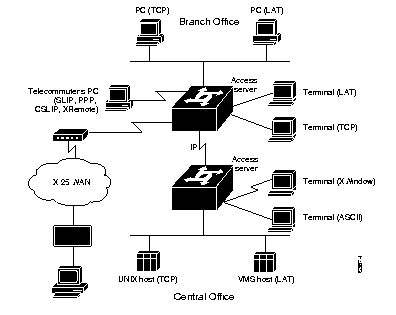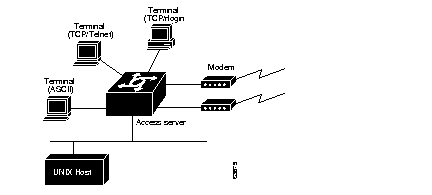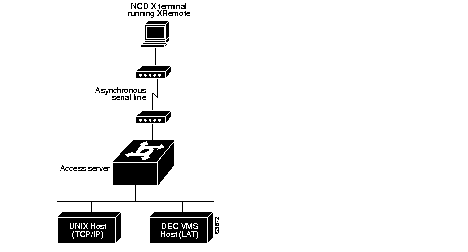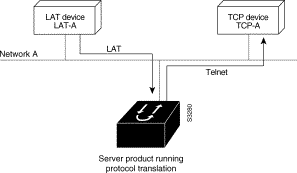This chapter provides a general description of the connection features supported on your server product (access server or router) to connect terminals, modems, microcomputers, and networks to local-area networks (LANs) or wide-area networks (WANs).
A user can dial in and use a line or interface for the following types of connections:
- Telnet
- LAT
- rlogin
- TN3270
- XRemote
- ARA for connecting from a Macintosh computer to an AppleTalk-based network.
- SLIP and PPP connections to a single PC
This range of functionality is possible because multiple roles can be assigned to each line. Each line can be a source of data for terminal-server communications (using Telnet, LAT, rlogin, and so forth), for remote-node services (using XRemote, ARA, and SLIP), or for terminal services or remote-node services using protocol translation.
Following are brief descriptions of the protocols and connection services supported by server products (access servers and routers).
- Transmission Control Protocol/Internet Protocol (TCP/IP) is the most widely implemented protocol suite on networks of all media types. TCP/IP is today's standard for internetworking and is supported by most computer vendors, including all UNIX-based workstation manufacturers. TCP/IP includes Telnet and rlogin.
- AppleTalk Remote Access (ARA) is the protocol that gives Macintosh users direct access to information and resources in remote locations. With this protocol, users can connect to another Macintosh computer or AppleTalk network over standard telephone lines.
- Serial Line Internet Protocol (SLIP) and Point-to-Point Protocol (PPP) are inexpensive methods of connecting a personal computer or workstation to a network using asynchronous dial-up modems.
- Local Area Transport (LAT) protocol is Digital Equipment Corporation's proprietary terminal connection protocol used with Digital minicomputers.
- IBM 3278 terminal emulation provides TN3270-based connectivity to IBM hosts over serial lines.
- Network Computing Devices Inc. XRemote terminal facility supports remote X Window operation.
Your server product supports three types of connection services (see Figure 1-1).
- Terminal services--Connecting together asynchronous devices running the same protocol (such as LAT or TCP) across a LAN or WAN through network and terminal-emulation software such as Telnet, rlogin, TN3270, and Local Area Transport (LAT). See Figure 1-2.
- Remote-node services--Connecting devices over a telephone network using SLIP, compressed SLIP (CSLIP), PPP, ARA, or XRemote (the NCD X Windows terminal protocol). See Figure 1-3 and Figure 1-4.
- Terminal or remote-node services using protocol translation--Connecting devices running dissimilar protocols (such as LAT-to-TCP or TCP-to-LAT) and converting one virtual terminal protocol into another protocol.
Figure 1-1: Connection Services

Terminal services provide terminal-to-host connectivity with virtual terminal protocols, including Telnet, LAT, TN3270, and rlogin. Modems can be set up for rotary connections, so that you can connect to the next available modem. A host can also connect directly to a server product. In IBM environments, TN3270 enables a standard ASCII terminal to emulate a 3278 terminal and access an IBM host across an IP network. In Digital environments, LAT support provides a terminal with connections to VMS hosts. Using LPD, you can also connect a UNIX host to a UNIX printer through an access server. On LANs, terminal services support the following types of connections:
- Telnet and rlogin connections using TCP/IP to UNIX machines
- TN3270 connections using TCP/IP to IBM machines
- LAT connections to Digital Equipment Corporation (Digital) machines
Figure 1-2 illustrates terminal-to-host connections.
Figure 1-2: Terminal-to-Host Connectivity

Using SLIP, CSLIP, or PPP, you can run TCP/IP applications, including Telnet, Simple Mail Transfer Protocol (SMTP), and File Transfer Protocol (FTP), over serial lines. You can get remote connectivity with the same functionality as a PC attached to a local network. Using ARA, you can connect from a Macintosh computer in a remote office into an AppleTalk LAN and have access to all Apple-based resources on that LAN. You can also use the XRemote protocol over asynchronous lines, because an access server can provide network functionality to remote X display terminals.
Remote-node services support WAN connectivity with SLIP, PPP, and XRemote. Other WAN services include X.25, Switched Multimegabit Data Service (SMDS), and Frame Relay. Full IP and IPX routing services are also supported. Access servers are network-compatible with routers, and you can use either device to extend your local-area network to any size you need.
Figure 1-3 illustrates an XRemote connection using an access server. Refer to the Access and Communication Servers Configuration Guide for additional possible XRemote configurations.
Figure 1-3: XRemote Connection

Figure 1-4 illustrates remote-node connections where remote users dial into an access server and connect to network services.
Figure 1-4: Remote-Node Connection

Protocol translation translates virtual terminal protocols so that devices running dissimilar protocols can communicate. Protocol translation on a server product supports Telnet, SLIP/PPP, ARA, LAT, and X.25.
There are two ways to make connections using a server product set up for protocol translation:
- One-step method--This method provides full transparent protocol translation using the translate global configuration command. In the configuration file of the server product, use this command to define a connection and the translation protocols so that you can make single-step connections to remote resources. A single-step connection means that you type at your terminal or work-station the command to connect to the remote device. The access server or router passes the connection directly through the remote device.
- With the one-step method, you perform bidirectional translation between any of the following protocols:
- X.25 and TCP
- X.25 and LAT
- LAT and TCP
- LAT, X.25, and TCP (Telnet) to SLIP and PPP
- For more information about using the one-step method, refer to the "Configuring Protocol Translation" chapter in the Access and Communication Servers Configuration Guide.
- Two-step method--This method enables connection to IBM or XWindows hosts from LAT, Telnet, rlogin, and X.25 PAD environments. Users must first connect to the server product supporting protocol translation, then use the TN3270 or XRemote facility that connects them to the IBM host. For more information about using the two-step method, refer to the chapter "Terminal or Remote Node Service Connections Using Protocol Translation" later in this publication.
- In general, you use the two-step method when you want temporary use of a server product supporting protocol translation as a general-purpose gateway between two types of networks (for example, X.25 PDN and TCP/IP). Instead of configuring the server product for every possible connection using the translate command, in the configuration file, the two-step method allows you greater flexibility in terms of connecting to network resources accessible via the server product supporting protocol translation. Figure 1-5 illustrates LAT-to-TCP protocol translation.
Figure 1-5: LAT-to-TCP Protocol Translation






